

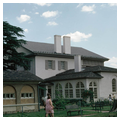

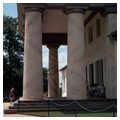
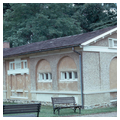
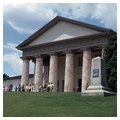
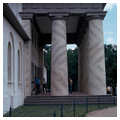
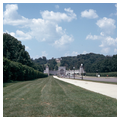

Buildings of Virginia: Tidewater and Piedmont, Richard Guy Wilson and contributors. New York: Oxford University Press, 2002, 45-47.
1802–1804. 1818, George Hadfield. Arlington National Cemetery. Open to the public
Arlington House (Custis-Lee House, Robert E. Lee Memorial) (Bill Sublette)
Arlington House (Custis-Lee House, Robert E. Lee Memorial) (Richard Guy Wilson)
Arlington House (Custis-Lee House, Robert E. Lee Memorial) (Richard Guy Wilson)
Arlington House (Custis-Lee House, Robert E. Lee Memorial) (Richard Guy Wilson)
Arlington House (Custis-Lee House, Robert E. Lee Memorial) (Richard Guy Wilson)
Arlington House (Custis-Lee House, Robert E. Lee Memorial) (Richard Guy Wilson)
Arlington House (Custis-Lee House, Robert E. Lee Memorial) (Richard Guy Wilson)
Arlington House (Custis-Lee House, Robert E. Lee Memorial) (Richard Guy Wilson)
(Richard Guy Wilson)
(Damie Stillman)










☰ SEE METADATA
The site is imposing, and the architect took full advantage, drawing upon several Greek models (the Temple of Poseidon, c. 460 B.C. at Paestum and the Temple of Hephaestus, c. 449 B.C. in Athens) to create one of the most sublime and dominant porticoes in the United States. The overscaled Doric columns (brick covered by stucco) became a landmark and influenced the future planning of Washington, D.C., particularly the placement of Memorial Bridge. The site was originally the center of a 1,000-acre plantation owned by George Washington Parke Custis, Washington's stepson, and his wife, Mary Lee Fitzhugh. Arlington House began as two small buildings completed between 1802 and 1804, which served as their home and a treasury of Washington memorabilia. The central section, uniting the two wings and creating a 100-foot-long facade (with wings it measures 140 feet) was designed by Hadfield, a Britishborn architect who had worked on the U.S. Capitol in 1795–1798. Hadfield's intention, following Custis's instructions, was to create a memorial for George Washington: a frontispiece for the display of Custis's collection of objects associated with the first president. At the house in 1831 Robert E. Lee married the Custises' daughter, Mary Anna Randolph, and subsequently the house became his property. During the Civil War the Union army occupied the house, and the federal government assumed title. Union dead were buried on the grounds, and an office of the Freedmen's Bureau for former slaves operated there. In 1873 Lee heirs sued for the return of the house, and after a Supreme Court decision, the federal government purchased the estate and used it for various purposes, including headquarters for the National Cemetery. Illustrating the changing nature of reputations, by 1925 Lee had become a national (rather than a southern) hero, and the mansion became a federal memorial dedicated to him. Restoration began under the war department and was transferred in 1933 to the National Park Service, which has continued to restore and maintain the property. The original floor plan remains. The interior decoration is a mixture of periods, though the focus is on the time of the Lee occupancy and especially the 1850s. In the south wing, elements of G. W. P. Custis's Washington “treasury” remain. To the west of the house are the former servant or slave quarters.